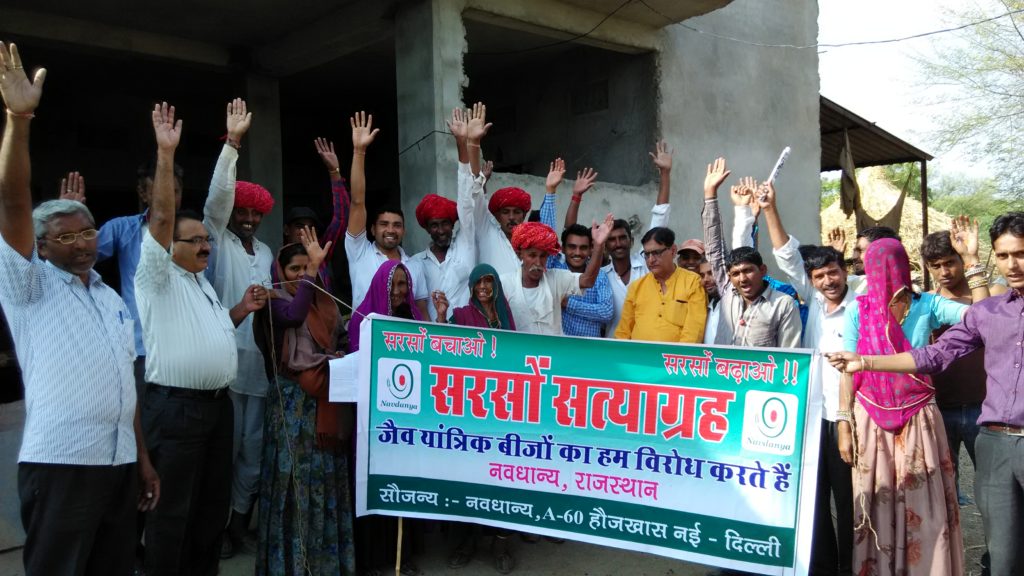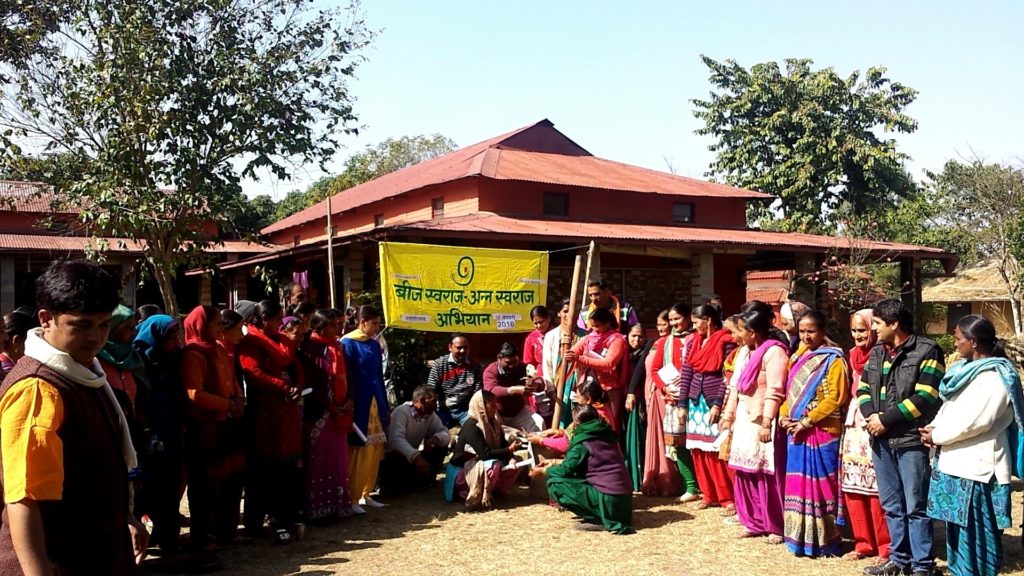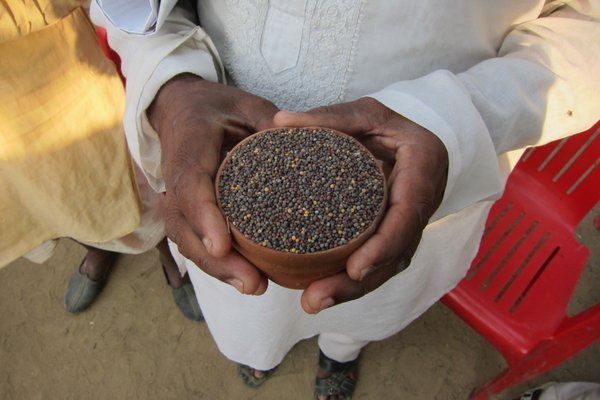
By Dr. Vandana Shiva
Mustard is the colour of our spring — basant. It is the flavour, and aroma, of our foods. It is a warm massage for a baby, and the glow of our oil-lamps on Diwali. Mustard has been central to the cultural and food identity of the diverse cultures that make up India. Mustard was the colour of freedom during our freedom movement. India’s mustard cultures and seed freedom are being threatened by the Poison Cartel, and Bayer-Monsanto.
There is a desperate push for introducing GMO Mustard, which will be the first GM food crop introduced into India. The attempt was made in 2016 to 2017, but it failed. And now another attempt is being made. On the 3rd of October 2022, the Supreme Court told the government to maintain the status quo till a hearing on the introduction of GM mustard was completed.
The push for this GMO is anti-science and anti-democracy. GMO mustard approval is a handing over of our democratic institutions to the Poison Cartel.
Thanks to the case of Bt Cotton, we have already seen what GMO crops can do in terms of destruction. Farmers have been committing suicide because of debt due to the high cost of seeds. Since Bayer-Monsanto has been focused on extracting patent royalties, the price of seed has jumped 80,000%. They have extracted Rs 7000 crores as illegal royalties. Under Indian Patent law article 3j, Bayer-Monsanto does not have a patent on BT cotton seed, since the law does not allow patents on seeds, plants and animals. But they have been manipulating and attacking India’s courts to weaken article 3j, thus attacking our democratic and farmers rights. This article is the legal expression of the concept of Vasudhaiva Kutumkam, or the Earth as one family.
For the poison cartel, there are no plants and animals with their own integrity. Life is a corporate “invention”. For Bayer-Monsanto GMO means God Move Over, we will now pretend to be creators of life to collect royalties and Lagaan. Patents and royalty collection is the endgame; GMOs are the excuse.
When the Competition Commission of India started an inquiry because 95% of the seed is controlled by Monsanto, Monsanto dragged the Competition Commission to court. The Monsanto and Bayer merger intensified the threat of monopoly over seed, the first link in the food chain. And when corporations get as big as Bayer-Monsanto, manipulating the courts and the government becomes very easy. If the Seed Price Control order is dismantled, and if the 3j article is removed, the GM mustard will fully become a Bayer-Monsanto mustard.

Sarson Satyagraha in Rajasthan, 2015 – Photo credits: Navdanya
Risky Genetic Transformations
In other words, the basic patents on the GM Mustard technology, as well as agrichemical package, are all owned by Bayer, as the Glufosinate (commercially called “Basta”) to be used with the GM mustard is also a Bayer herbicide.
The gm crop is based on multiple genetic transformations, and introduction of genes from unrelated organisms. These include the barnase gene for male sterility, bar-star gene, bar gene for herbicide resistance to Glufosinate (Basta, Bayer’s herbicide analogous to Monsanto’s Glyphosate), TA29 for regulator, CaMV 35S, Cauliflower Mosaic Virus (as a viral promoter), AMV, Alfa-alfa Mosaic Virus (as a viral promoter), and Agrobacterium tumefaciens as Terminators.
The original Food and Environmental safety assessment of the plant reveals that the barstar gene is to be found in the leaves, stem and roots of the GMO Mustard, and the Barnase gene is found in various vegetative tissues. The Bar gene is also found in the leaves, oil and oilseeds of the new plant. These are proteins that are not present in traditional mustard varieties.
However, the plant (as food) has not been assessed for safety, in its expression of the “layered” Bar “Trans Gene”, that has been implanted into the GMO mustard. What is tested, is surrogate proteins expressed in E Coli Bacteria. Isolated proteins expressed in bacteria are not equivalent to transgenes expressed in plants, which are much more complex organisms. Instead of testing for difference, a false assertion is dictated — that the two are equivalent.
The assessment also casually states, on page 63, “The data showed that the Barnase expression levels are below the detection level and yet the expression level is sufficient to create the male sterility trait”. As it is the expression of the trait that makes the difference in living systems, it is this trait that needs to be assessed in transgenic mustard as food.
Barnase is an enzyme that breaks down RNA indiscriminately and is known to be an extremely potent cell poison. Traces of barnase have been found to be toxic to rat’s kidneys and to human cell linings (Ilinskaya and Vamvaka, 1997; Prior et. Al., 1996).
The Barnase enzyme is also inhibited by the barstar protein. Both are produced by the soil bacterium Bacillus amyloliquefaciens. In the soil bacteria, these enzymes are bound, so barnase can do no harm. But when present in the plant, and when it is secreted from the cell, it is no longer bound and is thus harmful to other cells. It is exactly this harm that has not been scientifically assessed.
Additionally, there have been no official tests done on the safety of viral promoters.This is especially concerning as the Cauliflower Mosaic Virus, for example, is notoriously unstable (Ho, Ryan and Cummins, 1999). The CaMV 35S promoter taken from the Cauliflower Mosaic Virus is a DNA sequence used in commercial GMO crops for almost twenty years. It is also a classic example of how DNA can still reveal unexpected functions, even decades after discovery or use in a GM crop. The CaMV 35S DNA is described in every application for commercial use as a simple DNA “promoter” (as in, an “on” switch for gene expression). In 1999, however, the CaMV 35S “promoter” was found to encode a recombinational hotspot, meaning implanted genes were more likely to be unstable, resulting in likely horizontal gene transfer (Kohli et al., 1999). In 2011, it was found to produce massive quantities of small RNAs. These RNAs probably function as decoys to neutralize the plant immune system (Blevins et al., 2011). One year later still, regulators found these plants to contain an overlapping viral gene whose functions are still being elucidated (Podevin and du Jardin, 2012).
It is important to note that when first released in 2002, Pro-Agro’s (Bayer) application for the approval of commercial planting of GM mustard, based on the same transformations, was rejected by the Genetic Engineering Appraisal Committee (GEAC).

Basant Panchami celebration at Navdanya Farm, 2017 – Photo credits: Navdanya
The risk of GM Mustard is not necessary
Besides the instability and clear risks of the genetic transformations, there are many other risks associated with GMO-Mustard. With its Herbicide Resistant Trait, the new GMO will displace native mustard varieties, just like GMO-Cotton displaced Desi-Cotton in India. Genetic contamination from GM mustard will also be irrevocable and irreversible. Furthermore, mustard is grown as a mixture, with chana and wheat. Agrichemical spraying will also destroy the biodiversity of associated crops.
The sterility trait is introduced to produce non-renewable seeds. Just as has previously been the case, farmers will have to re-buy seeds every year, leading them to be trapped in debt, and be driven to suicide like the farmers growing GMO Bt cotton. An unnecessary violence, as in India, there already exists a diversity of local varieties of mustard coupled with traditional farming practices which give more yield without chemicals. The push for this GMO is therefore anti-science, especially as the main justification given for the necessity to genetic engineer with herbicide resistant traits, to resist Bayer’s herbicide, is to increase yields and curve the dependency on edible oil imports. The GMO mustard has lower yields than non-GMO alternatives available in the country. The government itself has admitted in the Supreme Court that increased yields are not being claimed, yet in the media this is the false claim being spun.
HT hybrid mustard DMH 11 has failed the first criteria of a test risk protocol of a GM crop, of whether the GM Crop is required in the first place. The answer in “No” based on the admission of the Union of India itself in their ‘Reply’ Affidavit in the Supreme Court. They said: “No such claim has been made in any of the submitted documents that DMH 11 out-performs Non-GMO hybrids. The comparison has only been made between hybrid DMH 11, NC (national Check) Varuna and the appropriate ZC (zonal checks) — MSY of 2670 Kg/ha has been recorded over three years of BRL trials which is 28% and 37% more than the NC & ZC respectively” (At 88, pg.56).
India can produce enough oilseeds that are diverse, healthy, safe, and culturally appropriate. In the 1990’s India had become self-sufficient in edible oils as a consequence of the conscious commitment to grow more oilseeds. The policy was called the “Yellow Revolution”, and it worked. In 1993-94 India was producing 97% of her requirements.

Native Mustard Seeds – Photo credits: Navdanya
Import Manipulation
In 1998, the same year that Monsanto sneaked in its BT cotton, the multinational companies (MNC) in India manufactured a crisis to get indigenous oilseeds banned and dumped GMO soya oil on India by manipulating a drop on import duties. India had bound its import duties at 300% in the WTO. The United States lobby had soya oil import duties reduced to 45%. In the manipulated crisis of 1998, the duties were dropped to 0%. In addition, the soya bean was subsidized by $190/tonne by the US government, and Rs 15/kg by India. It is no wonder then that India was flooded with imports. It was not because of domestic scarcity, but because of manipulated prices, manipulated trade and manipulated policy .
At that time, the women of the slums of Delhi called me to say their children could not eat the food cooked in soya oil. They wanted the mustard oil back. So we organized the “Sarson Satyagraha” in 1998 and saved our mustard. But the imports kept increasing through dumping and manipulation of policy. Compared to 1.02 million tonnes edible oil imports in 1996-97, India’s imports doubled to 2.98 million tonnes in 1998-99, and then jumped to 5 million tonnes in 1999-2000.
Today we are importing more than 60% of our domestic requirements. And destroying our coconut, sesame, groundnut, safflower, niger, mustard, and linseed diversity. All for GMO soya which is destroying the Amazon, and palm oil which is destroying the Indonesian rainforests. This has directly caused Indian farmers to lose livelihoods, and health.
We can grow enough oilseeds to meet India’s needs. As the farmers organizations wrote in a letter to the Environment Minister, Anil Dave: “Oil seed production has taken a hit due to bad pricing/procurement support from the government, and inappropriate anti-farmer import policies adopted by the government. It is not because we are unable to produce enough or do not have the seeds or know how. If the pricing, procurement and import policies are made farmer friendly we assure you that we can produce all the mustard and other oil seeds the country needs.”
Today, the government of India is again being manipulated by the same interests that forced the edible oil imports on India, to now force GMO Mustard in the name of reducing import dependence.
The unscientific and corrupt approval for GMO Mustard is simultaneously an approval to 100 other crops that are undergoing trial. We stopped Bt Brinjal in 2010. There was a democratic consensus in India that we would not become victims of GMO foods. The 2020 decree by Mexico President Andres Manuel Lopez Obrador aims to phase out GM corn and the herbicide glyphosate by 2024.
The decision about GMO Mustard is not merely a technological choice. It is about our Seed Freedom and Food Freedom. Since GMO technology has been pushed primary to own the seed through patents to collect royalties, since such patents cannot be granted without dismantling the public interest and national interest built into our structures, laws and policies, GMO mustard is a recipe for the colonization of India by the Poison Cartel Bayer- Monsanto. If GMO mustard is approved, India as a free, democratic, sovereign country dies. If GMO crops are approved, and article 3j of our patent laws is diluted, misinterpreted, and distorted, India as a civilization dies and becomes a colony in the toxic empire of the Poison Cartel.
This is why we are continuing the Sarson Satyagraha we started in 1998 – to keep India free, healthy and prosperous.
(Dr. Vandana Shiva was appointed by the UN to an expert group to create the Biosafety Framework to implement art 19.3 of the Convention on Biodiversity (CBD). This framework evolved into the Cartagena Protocol on Biosafety. Dr Shiva has also served on the National Expert Group which drafted India’s National Biodiversity Act, and the Plant Variety Protection and Farmers Rights Act.)
Bibliography:
Blevins T, Rajeswaran R, Aregger M, Borah BK, Schepetilnikov M, Baerlocher L, Farinelli L, Meins F Jr, Hohn T, Pooggin MM. Massive production of small RNAs from a non-coding region of Cauliflower mosaic virus in plant defense and viral counter-defense. Nucleic Acids Res. 2011 Jul;39(12):5003-14. doi: 10.1093/nar/gkr119. Epub 2011 Mar 4. PMID: 21378120; PMCID: PMC3130284.
Ilinskaya ON, Vamvakas S. Nephrotoxic effects of bacterial ribonucleases in the isolated perfused rat kidney. Toxicology. 1997 Jun 6;120(1):55-63. doi: 10.1016/s0300-483x(97)03639-1. PMID: 9160109.
Kohli, A., Griffiths, S., Palacios, N., Twyman, R., Vain, P., Laurie, D.A. and Christou, P. (1999), Molecular characterization of transforming plasmid rearrangements in transgenic rice reveals a recombination hotspot in the CaMV 35S promoter and confirms the predominance of microhomology mediated recombination. The Plant Journal, 17: 591-601. https://doi.org/10.1046/j.1365-313X.1999.00399.x
Mae-Wan Ho,, Angela Ryan, & Joe Cummins (1999) Cauliflower Mosaic Viral Promoter – A Recipe for Disaster?, Microbial Ecology in Health and Disease, 11:4, 194-197, DOI: 10.1080/08910609943562.
Podevin N, du Jardin P. Possible consequences of the overlap between the CaMV 35S promoter regions in plant transformation vectors used and the viral gene VI in transgenic plants. GM Crops Food. 2012 Oct-Dec;3(4):296-300. doi: 10.4161/gmcr.21406. Epub 2012 Aug 15. PMID: 22892689.
Prior TI, Kunwar S, Pastan I. Studies on the activity of barnase toxins in vitro and in vivo. Bioconjug Chem. 1996 Jan-Feb;7(1):23-9. doi: 10.1021/bc9500655. PMID: 8741987.
